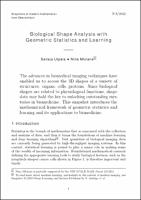| dc.contributor.author | Utpala, Saiteja | |
| dc.contributor.author | Miolane, Nina | |
| dc.contributor.editor | Munday, Sara | |
| dc.contributor.editor | Randecker, Anja | |
| dc.date.accessioned | 2022-10-25T09:28:10Z | |
| dc.date.available | 2022-10-25T09:28:10Z | |
| dc.date.issued | 2022-10-25 | |
| dc.identifier.uri | http://publications.mfo.de/handle/mfo/3985 | |
| dc.description.abstract | The advances in biomedical imaging techniques have enabled us to access the 3D shapes of a variety of structures: organs, cells, proteins. Since biological shapes are related to physiological functions, shape data may hold the key to unlocking outstanding mysteries in biomedicine. This snapshot introduces the mathematical framework of geometric statistics and learning and its applications to biomedicine. | en_US |
| dc.language.iso | en | en_US |
| dc.publisher | Mathematisches Forschungsinstitut Oberwolfach | en_US |
| dc.relation.ispartofseries | Snapshots of modern mathematics from Oberwolfach;2022-08 | |
| dc.rights | Attribution-ShareAlike 4.0 International | * |
| dc.rights.uri | http://creativecommons.org/licenses/by-sa/4.0/ | * |
| dc.title | Biological shape analysis with geometric statistics and learning | en_US |
| dc.type | Article | en_US |
| dc.identifier.doi | 10.14760/SNAP-2022-008-EN | |
| local.series.id | SNAP-2022-008-EN | en_US |
| local.subject.snapshot | Geometry and Topology | en_US |
| local.subject.snapshot | Probability Theory and Statistics | en_US |
| dc.identifier.urn | urn:nbn:de:101:1-2022112209312693372541 | |
| dc.identifier.ppn | 1823161618 | |


